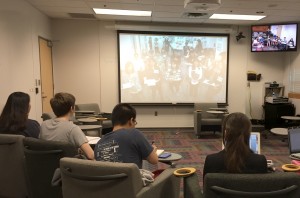
Kyoko Kurita, in Asian Languages and Literatures at Pomona College, has been using video conferencing technology as a regular part of her language and cultural education curriculum since 2004 in her advanced-level Japanese classes. She calls a video conference “90-minute study abroad,” and conducts one or two video conference each semester.
According to Professor Kurita:
A video conference is a 90-minute study-abroad. But it goes beyond that. Even as the ubiquity of the internet reinforces the global linguistic dominance of English, it enables us to learn from other ways of approaching life. Three million people are currently studying Japanese in educational institutions worldwide. So Japanese, also, can be a tool for international communication.”
Students prepare for discussions or debates by writing up ideas and practicing speaking in class. Then, during the video conference, they also have to cope “live” with the unexpected: real time, real people, real dialog. Afterwards, students in both groups write up reports on the discussion and exchange them, for further education in language, culture, and perspective. Kurita notes:
The most valuable part of the video conferencing experience is that despite all the preparation, the actual discussion never goes according to the plan. So they have to devise an alternative course of action on the spot. I recall one especially memorable instance in which my students surprised the Japanese students by saying that they were against the Gulf War. The students at Keio University were fully expecting that my students would be all for the war. So they were totally deflated. This was an important discovery for the Japanese students, and also for my students to learn that antiwar sentiment exists beyond national borders.
The experience of speaking with non-native speakers of Japanese is also a valuable linguistic and cultural exercise. With the ubiquity of the internet in the world, English has become a universal language; but while we acknowledge the importance of knowing English, it is all the more important to learn and maintain different languages. Our students find that although they may have different accents, students in different countries sometimes make the same mistakes as they do, so they all feel that they can share the joy and the pain of learning the same language. They also learn that the manner of leading a discussion varies in each country.
Her group of video conference partners includes colleagues at Keio University, Tokyo University of Foreign Studies, Tokyo Woman’s Christian University in Japan, Tsinghua University in China, Ghent University in Belgium, and the University of Koeln (Cologne) in Germany.
Kurita co-authored an article about the effectiveness of video conferencing with Yuka Kawaji of Tokyo University of Foreign Studies, “Terebi kaigi shisutemu wo tōshita Nihongo no Nichibei kōryū jugyō ni okeru manabi no kōsatsu” (A Study of the Learning Process in a US-Japan Video Conference Conducted in Japanese), in Nihongo kyōiku kenkyū (Studies of Teaching of Japanese) 60 (November 2014), 43-57.
For more information about Professor Kurita’s teaching and research, see:



